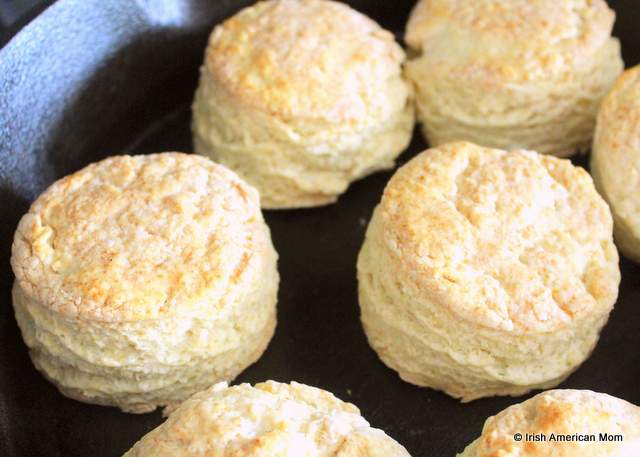Ireland revisited: Buttermilk scones

FOOD MATTERS
by Kristin Hamaker, columnist
Ireland revisited
I arrived in Cork City, Ireland, on a spring day in 2005. But my luggage had not, nor my kitchen knives, or anything that tethered me to home. I was bare, and on my way to begin an adventure in cooking at the tiny and perfectly quirky Ballymaloe Cookery School for a spring/summer immersion course.
That program changed me. I walked in a little arrogant, expecting some affirmation of my culinary expertise. And then I let it all go. I really had to since the course was impressively rigorous, reaching far beyond my current scope. The school sits on its own sustainable working farm, where animals pasture and vegetables grow in abundance, all beside the shores of the Celtic Sea. All is collaborative and integrated, and that is the point.
The small group of us international students milked cows before dawn and baked bread in early ovens. We cooked difficult dishes in cramped kitchens, all under the serious eyes of instructors, including the matriarch, Darina Allen. This woman, in this unassuming place, really offered up the big picture on sustainable eating and cooking, down to saving kitchen scraps for the chickens that, in turn, provide compost for the garden beds.
I’ve been rereading her book “Forgotten Skills of Cooking,” and feel particularly soft since it’s March when St. Patrick’s Day (a day, by the way, that is deeply unrecognized in Ireland) awakens our fascination with this faraway place. I always make a few proper Irish soda breads this month and bring them along as gifts. In Darina’s honor, here is my soda bread contribution in the way of scones.
Buttermilk Scones
Sweet or Savory
Makes 8 scones. We make these all the time in our house; I could make them blindfolded, if it wasn’t for the hot oven. Whether or not they are sweet or savory, we always smother them with salted butter. This recipe looks long but that’s because I’ve folded in a bit of baking wisdom!
Market List
4 cups all-purpose flour (or in combination with whole wheat pastry flour; plus extra flour for dusting)
1 teaspoon baking soda
1 teaspoon kosher salt
2 teaspoons sugar
1 large egg
15 oz buttermilk
Apron On
Preheat your oven to 425°F. In your largest and widest bowl sift 4 cups, of all-purpose flour, 1 teaspoon baking soda, 1 teaspoon kosher salt, and 2 teaspoons of sugar. Mix well with your hands or use a whisk. Look below for ideas on additions. Mix or whisk well again once you’ve added any addition. (Of course, you can also make these plain — they are just as delicious.)
Into a large measuring cup (or bowl), break one large egg and whisk briefly. Add 15 oz. of buttermilk to the cup (or bowl), and whisk well. Make a well in the dry ingredients, and add in most of your buttermilk, leaving behind ¼ cup or so. (This leftover is insurance, in the case your mix is too dry, and also can be used to glaze your scones before they go into the oven.) Place your largest cutting board (or use a clean counter space) and dust it liberally with flour. If you are using a baking stone, make sure it is on the middle rack of your oven, or ready a cookie sheet with a length of parchment paper (not wax paper), or if you don’t have parchment, dust the sheet lightly with flour.
Now, using your hands (a fun, messy, and more direct approach) or a wooden spoon, patiently and little-by-little incorporate the dry ingredients into the wet, working from the inner reaches, circling outward. (This may be clumsy at first, but the more you practice it the more at ease you will become.) The idea is to not overmix your dough, but to be light-handed; this will be at first an imperfect process. Overmixing diminishes the lightness of the final product. If your dough is still too dry and not coming together into a shaggy ball, add just a bit more of your buttermilk to tidy it up. Roll it out onto the edge of your cutting board, and then flip it over one more time to the middle of your cutting board; the flour on your board should prevent sticking. Rinse and dry your hands. Flour your hands and pat your dough gently into a circle with one-inch height.
Oven-Ready
Divide the dough into 8 triangles, as you would for a pizza. With a brush, or your fingers, glaze each scone lightly with any remaining buttermilk and egg mix. Place each scone onto the baking stone, or your cookie sheet, and bake for 15 minutes. Turn the oven down to 400°F and bake for a further 5-10 minutes, until they’re golden. Let them rest on a cooling rack.
NOTES & VARIATIONS
• For sweet scones, consider adding to the dry ingredients ¾ cup of dried fruit or crystallized ginger (chopped, if the fruit is large-cut), ½ cup chocolate chips or chopped bittersweet chocolate. For savory scones, consider adding to the dry ingredients a few tablespoons of a finely chopped fresh herb, such as dill or rosemary, or a seed such as cumin or fennel.
• Store your scones in a Ziploc-style bag, well after cooling, or freeze any for later.
• Beyond triangles, you can stamp your scones into any scone-favorite shape.
Kristin is a chef, meal planner, and the founder of Goosefoot Kitchen. She teaches, writes on, and advocates for the good life in and around the kitchen and at the table.



